From Colosseum to the Vatican City, and from the most delicious gelato to the tastiest spaghetti you’ve ever tried, this itinerary will help you spend 3 unforgettable days in Rome.
Rome’s second name is the Eternal City.
Another description that I think suits it perfectly is the “City-Museum.”
A walk through its historic center immediately clarifies why.
Whichever street you walk, there is something to admire.
Enter an unexpected alley, and you realize it’s just as charming as the spot you had marked on the map.
Sights that in other cities would be considered top-notch, in Rome, may not even impress you since you’ve already seen something more impressive.
At the same time, its cuisine is like the best dreams of every food lover.
Pizza, spaghetti, gelato, tiramisu, and panna cotta, as well as Italian wines and aperitifs, dominate the restaurants, satisfying even the most demanding guests.
How many days do you need in Rome?

If you don’t mind following a tight itinerary, like the one below, 3 days can be enough to see the best of Rome.
You certainly won’t be able to see everything – probably not even a week would be enough.
However, 72 hours is sufficient to get an excellent first impression of the city and visit landmarks such as the Colosseum, the Trevi Fountain, and the Roman Forum.
At the same time, you will have time to eat pizza in the picturesque restaurants of Trastevere and enjoy your aperitif with a view of the Pantheon.
If you have four days at your disposal, then you can either follow a more relaxed pace or spend more time in the city’s fascinating museums.
How to see the best of Rome in 3 days?

All this beauty, as you would expect, attracts many tourists.
Actually, possibly more tourists than any other city you’ve visited.
A well-planned 3-day itinerary is, therefore, necessary to explore Rome, but it is not enough by itself.
So, a very important tip: start your days as early as possible by visiting the most popular attractions when they open.
Also, buy skip-the-line tickets at as many landmarks as you can without a second thought.
The following guide is designed with this very logic in mind.
At the beginning of each day, I start with a famous destination, while in Vatican City and the Colosseum, I recommend highly rated tours with skip-the-line tickets.
Where to stay in Rome for your first time?

If you have read my other city guides, e.g., for Athens, Bucharest, Prague, Hamburg, or Krakow, you know that I like to stay in the center and explore the city on foot.
Rome is not an exception to this rule; on the contrary, it reinforces it, as walking its streets is a real pleasure.
So for our stay, we chose the Hotel Varese Roma, which turned out to be a decent choice: clean, affordable for the city’s standards, and surrounded by many shops.
In less than 30 minutes on foot, we were at attractions such as the Trevi Fountain, the Colosseum, and Villa Borghese.
At the same time, it is less than five minutes away from Termini train station, which provides easy and fast access to Fiumicino Airport.
From Termini train station, there is also public transport to all destinations within the city – even so, we never used them.
If you prefer luxury, you should consider the Baglioni Hotel Regina, one of the best five-star hotels in Rome.
Alternatively, if you’re traveling on a budget, check out the Comics Guesthouse Hostel. It is in an excellent location, with friendly and helpful staff.
How do you get to Rome?
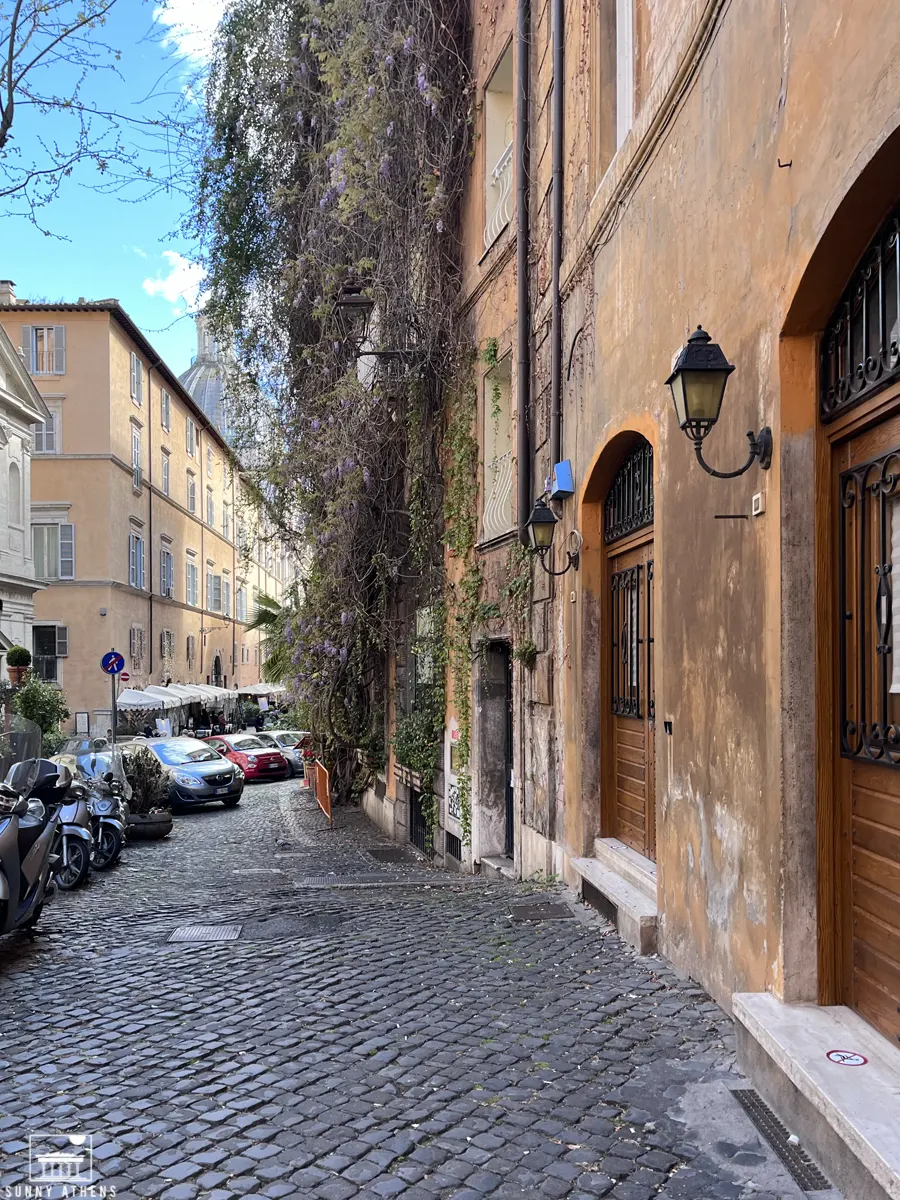
The city has two airports: Fiumicino Leonardo da Vinci International Airport (FCO) and Ciampino Airport (CIA).
The central and larger of the two is Fiumicino, serving most international flights.
Surprisingly, Ciampino is slightly closer to the center of Rome.
However, Fiumicino has easier access, and you often need less time to get to the city.
Since the roads are often congested, the fastest way is the Leonardo Express train.
It takes you from the airport to Roma Termini in exactly 32 minutes, without intermediate stops.
You can book tickets directly from the website of the Italian railways, Trenitalia.
Alternatively, you can take an Uber or a pre-booked taxi.
The service I use on my trips is Welcome Pickups, as they wait for you at the arranged meeting point, even if your arrival is delayed, and they have numerous positive reviews on TripAdvisor and Trustpilot.
So, even though their flat rate is a few euros more expensive, they are worth it.
3 Days in Rome Itinerary: Day 1
The recommended route for your first day
The first day begins early in the morning at the Colosseum, as it quickly becomes crowded, much like all the highlights of Rome.
However, since the day’s itinerary is circular, you can start from any point of interest, depending on where you are staying and whether you have booked a tour.
1. Colosseum

Why: The Colosseum is your first stop on this 3 days itinerary in Rome.
It is the ideal starting point to immerse yourself in the city’s imperial history.
Its construction took place between 69 and 81 AD, and it is estimated that it could accommodate up to 80,000 spectators.
Gladiator competitions, animal hunts, and re-enactments of famous battles were held in its arena.
Today only a part of it survives, as severe earthquakes led to its partial collapse.
If you are interested in history, consider booking this guided tour. It is the same one we chose, and we were very satisfied.
2. Roman Forum

Why: Directly opposite the Colosseum is the Roman Forum.
On your way to its entrance, make sure you pass by the Arch of Constantine, which was built in 315 AD and is dedicated to Emperor Constantine the Great.
A few minutes later, you will find yourself inside the Roman Forum, which is more like an open-air museum.
The ancient monuments that you can see here are truly countless.
The best thing you can do is walk as much as possible inside the archaeological site and simply enjoy it.
If I had to highlight two attractions, they would be the gigantic Basilica of Maxentius, and the Antoninus and Faustina Temple, built by Emperor Antoninus for his wife, Faustina.
3. Palatine Hill

Why: Continuing your walk, head towards Palatine Hill.
According to tradition, the founding of Rome started here.
In ancient times, wealthy residents had their homes here, and later the Roman emperors built their palaces in the same location.
Make sure you reach the Terrazza Belvedere del Palatino to enjoy a unique view over the entire Roman Forum.
4. Campidoglio

Why: Leaving the Roman Forum, in less than 10 minutes on foot, you arrive at Campidoglio.
It is a square surrounded by buildings with impressive architecture designed by Michelangelo.
At its center, the statue of Marcus Aurelius stands prominently, and the entrance to the Capitoline Museums is also here.
Right behind it, you will find another viewpoint with an excellent view of the Roman Forum.
5. Altar of the Fatherland

Why: Descending the steps of the Campidoglio, the Altar of the Fatherland begins to emerge on your right.
It is a much more modern monument than what you have seen so far today, as it was built between 1885 and 1935 AD.
It is dedicated to the first king of unified Italy, Victor Emmanuel II, and also to the Italian Unknown Soldier.
To enjoy a panoramic view of it, you will need to be in the middle of Piazza Venezia, which is right across the street.
6. Forno Campo de’ Fiori

Why: At this point, it’s time for a first quick stop for food.
Head towards Campo de’ Fiori, passing first by Palazzo Bonaparte, where Napoleon’s mother lived, and Largo di Torre Argentina, the archaeological site near which Julius Caesar was killed.
Upon arriving at the square, you’ll find many hawkers selling local products, such as fruits and vegetables.
Right next to the square is Forno Campo de’ Fiori.
Grab their simple and delicious pizza margherita and pizza bianca and enjoy them in the square while people-watching.
7. Tiramisu at Two Sizes

Why: After a quick stop at the Parrocchia Santa Maria in Vallicella, perhaps the best tiramisù we tried in Rome awaits you.
You’ll likely have to wait in line at Two Sizes, but the wait is worth it.
Its cream is incredibly fresh and melts in your mouth, and the prices are very affordable.
Don’t forget to try the original and the pistachio tiramisù!
8. Piazza Navona

Why: In less than two minutes on foot, you are in the most famous square included in this 3 days itinerary of Rome.
Originally built by Emperor Titus Flavius Domitianus in 80 AD, Piazza Navona was rebuilt between the 15th and 17th centuries.
Today it is surrounded by architectural works of art, but the Fountain of the Four Rivers stands out at its center.
Its statues depict four rivers: the Nile from Africa, the Danube from Europe, the Ganges from Asia, and the La Plata River from America.
Above them is the Egyptian Obelisk of Domitian, on top of which is placed a dove with an olive twig.
9. Church of St. Louis of the French
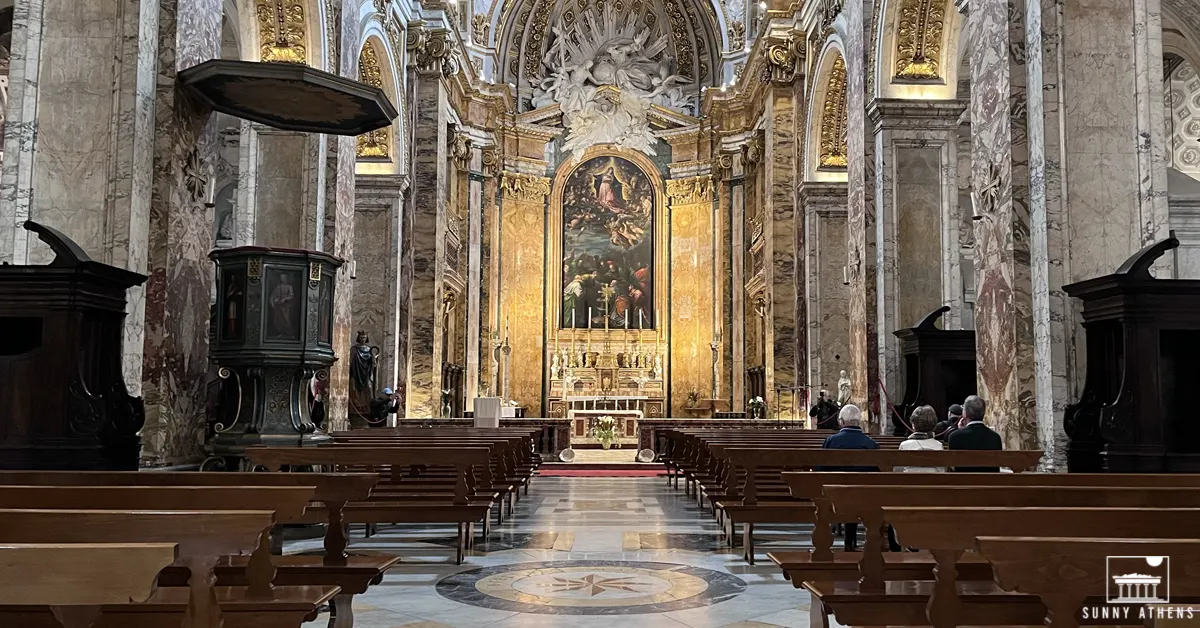
Why: In most cities around the world, you visit museums when you want to see masterpieces of painting.
In Rome, you merely need to enter churches like that of St. Louis of the French.
Notably, it houses three impressive works by Caravaggio, created between 1599 and 1602: The Calling of St Matthew, The Inspiration of Saint Matthew, and The Martyrdom of Saint Matthew.
As you observe these pieces, be sure to focus on Caravaggio’s use of chiaroscuro, a famous technique featuring strong contrasts between the bright and dark parts of the painting.
10. Pantheon

Why: The ancient Greek term “Pantheon” means “of all the gods”.
This was the primary purpose of the temple when it was built in the 1st century AD by Marcus Agrippa.
After a fire nearly completely destroyed it, Emperor Hadrian had to rebuild it in the 2nd century AD.
Remarkably, in the 7th century AD, it was converted into a church, but it still maintains its original form to this day.
As a result, it’s the best-preserved of all Ancient Roman buildings, having stood unchanged for almost two millennia.
Needless to say, it’s a must-visit destination, but be prepared to wait in a queue to get inside.
One particular highlight of our trip was the unforgettable experience of enjoying an aperitif with a view of the temple.
I highly recommend taking an hour to relax in one of the cafes located on Piazza della Rotonda.
11. Church of St. Ignatius of Loyola

Why: The city tour continues, passing the Temple of Hadrian, and entering the Church of St. Ignatius of Loyola.
This remarkable church, completed in 1650 AD, has a notable feature: its ceiling, painted using the trompe-l’œil technique.
This optical illusion makes two-dimensional surfaces appear as three-dimensional objects.
A stop at the mirror in the center of the church will help you understand exactly why it is considered so impressive.
12. Trevi Fountain

Why: Words fail to adequately describe the Trevi Fountain.
Built in 1762 over an ancient water source, its theme is inspired by Greek mythology.
The central figure is the Titan Oceanus, flanked by statues of Tritons guiding two sea-horses.
Its fame and unique beauty attract tens of thousands of tourists every day.
Astonishingly, the coins dropped into the wishing well amount to 1.5 million euros a year – or about 1.7 million dollars!
Despite the crowds, you can enjoy the fountain if you’re patient enough to get to the front.
However, be very careful with your belongings, as the location is a haven for pickpockets.
And don’t forget: according to legend, throw a coin into the water with your right hand over your left shoulder, and you’ll return to Rome!
13. Papal Basilica of Santa Maria Maggiore
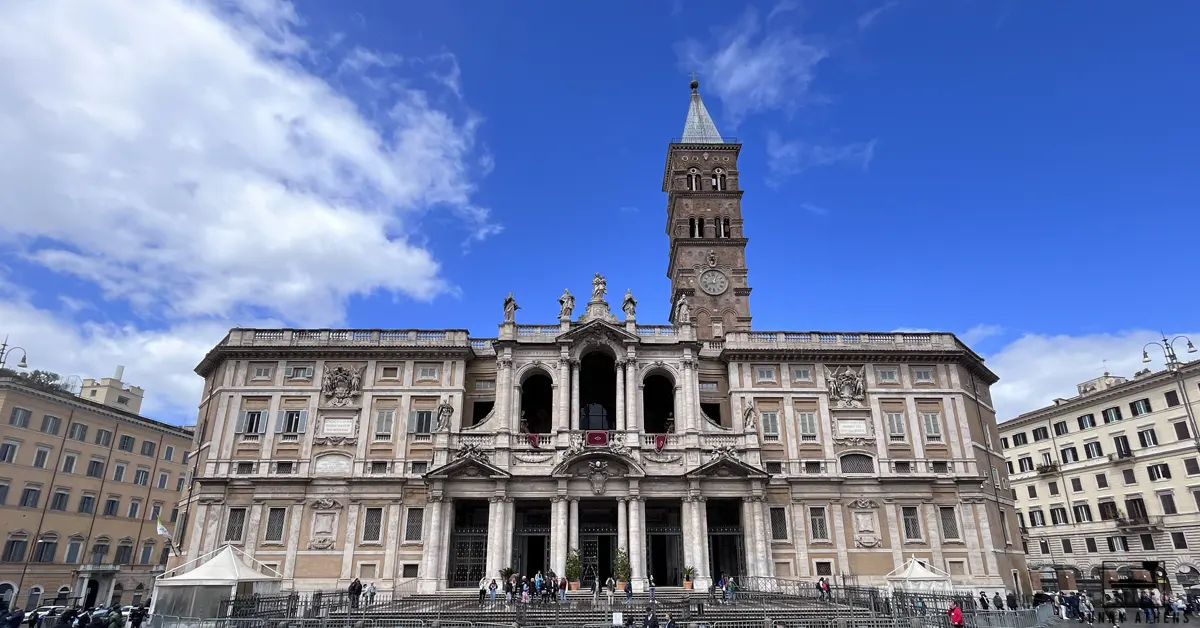
Why: Just before the end of the first of 3 days of your Rome itinerary, head to the Papal Basilica di Santa Maria Maggiore.
On your way, don’t miss the Quirinal Palace, residence of the president of the Italian Republic.
Upon arrival, you’ll surely be struck by the church’s exterior.
But once you enter, you’ll be truly impressed.
The Ionic-style columns harmoniously combine with detailed mosaics and stunning frescoes.
It is undeniably one of the most beautiful churches in Rome.
14. Pizza and Pasta

Why: The day concludes with, what else, classic Italian pizza and spaghetti.
Just a five-minute walk away from where you are is Tosca – Trattoria Pinseria.
We chose the Carbonara della Tosca and the Marinara pizza from the menu, both of which were very tasty.
Alternatively, nearby is the restaurant Nerone, which has excellent reviews.
However, you’ll need to make a reservation in advance as it fills up quickly.
3 Days in Rome Itinerary: Day 2
The recommended route for your second day
Vatican City

Before we start the itinerary for your second day in Rome, here’s some very important information.
First, you’ll spend about half a day in Vatican City.
Given the wealth of exhibits, this period barely scratches the surface of what the city-state has to offer.
You’d likely need a whole week to see everything, so try to make the most of your available time.
Second, do yourself a favor and buy early access tickets to the Vatican Museums.
Don’t let the extra cost or the early wake-up time deter you.
If you don’t, calling the crowds ‘overwhelming’ would be a serious understatement.
Third, and most importantly, as you can read in the disclaimer at the end of this article, this site is reader-supported, and all evaluations are based on my personal opinions.
This fact allows me to write what I truly believe, with the goal of helping you make better decisions about your trips.
With that in mind, be very careful when choosing a guided tour.
We chose this specific tour, and it was a terrible experience.
We had to wait about an hour in queues to get into the museums, the headsets they provided didn’t work most of the time, and the tour coordination was generally poor.
However, I believe a guided tour is almost essential to comprehend the vast amount of information you’ll receive during your visit and to connect the dots in the narrative.
Should we visit again, we wouldn’t hesitate to book an early entry tour like this one.
It’s more expensive, but the experience justifies the cost.
15. Vatican Museums

Why: The Vatican Museums rank among the world’s most significant, housing countless masterpieces.
To grasp the breadth of their exhibits, consider that there are 20,000 works of art on display, with about 50,000 other pieces not even in public view!
It’s a challenging task to highlight any individual items, but if I had to pick five must-sees, they would be:
- The School of Athens, a fresco by the Italian painter and architect Raphael.
- The Belvedere Torso, which played a catalytic role in Renaissance art.
- The Gallery of Maps, the world’s largest pictorial geographical study by Ignazio Danti.
- The Round Hall, with its stunning mosaics and a massive red porphyry basin.
- The Laocoön and His Sons, the nearly life-sized statue, depicting profound human agony.
16. Sistine Chapel

Why: Technically, the Sistine Chapel is part of the Vatican Museums.
However, Michelangelo’s masterpieces truly stand out and thus deserve at least one special mention in this 3-day itinerary of Rome.
Personally speaking, I find the Sistine Chapel ceiling and The Last Judgment to be the most moving artworks I’ve ever seen, a feeling only paralleled by my experience with El Greco’s works in the Prado in Madrid.
For context, the ceiling, which was completed between 1508 and 1512, depicts nine scenes from the Book of Genesis.
Meanwhile, The Last Judgment, finished about 25 years later between 1536 and 1541, represents the second coming of Christ and God’s final judgment of humanity.
17. St. Peter’s Basilica

Why: Moving on to St. Peter’s Basilica, it is likely the most awe-inspiring church you’ll ever enter.
Originally constructed in the 4th century AD by Emperor Constantine the Great, it was completely transformed between 1506 and 1626, taking on its current form.
According to Catholic tradition, beneath the Holy Altar of the church, you’ll find the burial place of Saint Peter.
Looking up from there, you can see the imposing Dome, one of the largest in the world.
Among the countless other exhibits, ensure you don’t miss the Chair of Saint Peter, St. Peter’s Baldachin by Bernini, and Michelangelo’s Madonna della Pietà.
18. Janiculum Hill

Why: After leaving the bustling crowds of Vatican City, it’s time to switch gears and explore something entirely different.
A short distance away lies Janiculum Hill, a serene park offering breathtaking views of Rome.
Despite its stunning scenery, it remains a hidden gem for many tourists, making it the perfect spot for walking and relaxing.
19. Fontana dell’Acqua Paola

Why: As you descend towards Trastevere, you will encounter the Fontana dell’Acqua Paola on your path.
Built in 1612 by Pope Paul V, this fountain served as inspiration for the Trevi Fountain.
It remains relatively unvisited by tourists despite its unique design, allowing you to enjoy it in peace without crowds or queues for photos.
However, do take note of the road directly in front of it, as cars often speed by with little visibility.
20. Basilica of Santa Maria in Trastevere

Why: The 3 days itinerary of Rome continues with one of its most charming neighborhoods, Trastevere.
After taking enough time to stroll through its picturesque narrow streets, the Basilica Of Santa Maria In Trastevere awaits you.
Situated in Piazza di Santa Maria, a popular nightlife destination for both locals and tourists, the church is one of the oldest in the city, with its origins dating back to the 4th century AD.
While its exterior may not be impressive, the interior is unique, featuring a combination of mosaics, granite columns, and a baroque ceiling.
21. More Pasta

Why: At this point, it’s time for another delightful dinner.
As you’ll soon notice, Trastevere is filled with restaurants and bars.
We chose Nannarella and savored the most delicious pasta of our entire trip to Rome.
Specifically, we ordered the lasagna and the carbonara, both of which were exceptional: fresh ingredients and satisfying portions without leaving you feeling overly full.
Be prepared to wait in line for a table, but rest assured; it’s well worth the wait.
Alternatively, you could also try the highly rated Tonnarello, which is nearby.
22. Orange Trees Garden

Why: The day concludes on the opposite side of the River Tiber.
A roughly 20-minute walk will take you from the center of Trastevere to the Orange Trees Garden.
This park offers an ideal setting for a leisurely walk and some relaxation after a busy day.
From here, you can enjoy one of the best views of the city, with St. Peter’s Basilica’s dome featured prominently in the landscape.
3 Days in Rome Itinerary: Day 3
The recommended route for your third day
23. Villa Borghese
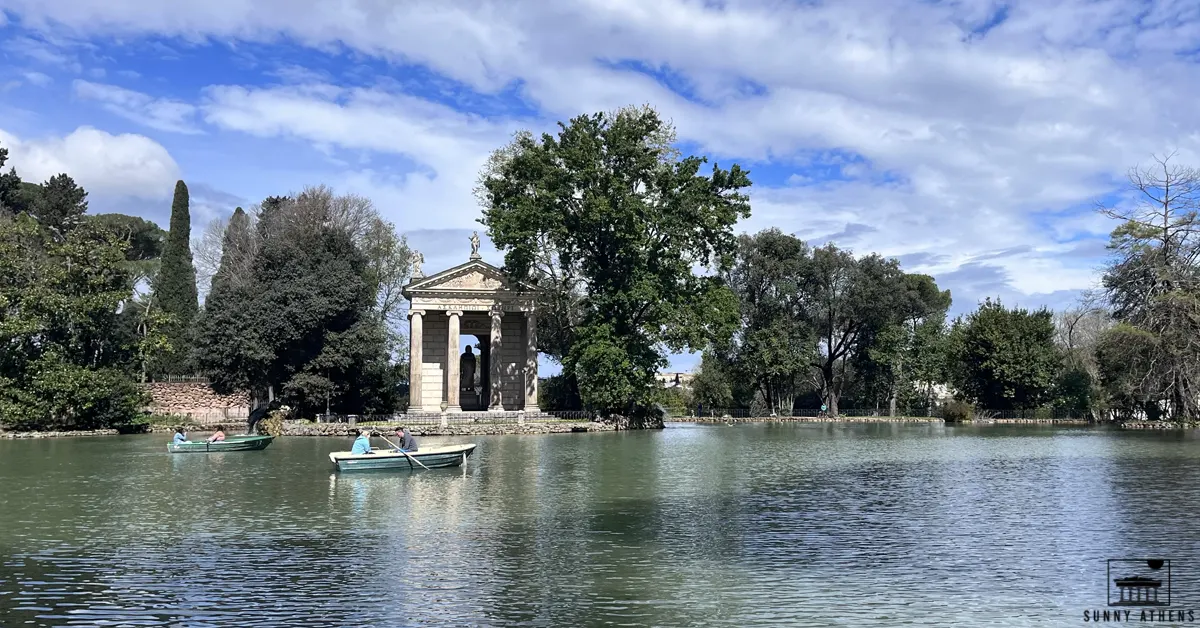
Why: The third day of your Rome itinerary begins with a visit to one of the city’s largest and most beautiful parks, Villa Borghese.
This expansive area features gardens, open spaces for sports and walks with pets, small lakes, and, of course, the renowned Borghese Gallery and Museum.
Inside the museum, you’ll find a wealth of art pieces that Scipione Borghese began to collect, including works by Raphael, Caravaggio, and Bernini.
If you love sculpture and painting, a visit is absolutely worthwhile.
However, on our visit, we opted for a less conventional choice and bypassed the museum.
Instead, we decided to spend three leisurely hours strolling through the park.
This decision to relax turned out to be excellent, with our coffee break in the park’s cafe, accompanied by music from a nearby street artist, becoming one of the highlights of our trip.
24. Piazza del Popolo

Why: After exiting Villa Borghese and taking in the panoramic view of the entire city, you’ll find yourself at the famous Piazza del Popolo.
The name translates to “Square of the People,” and in ancient times, this was where the city’s northern entrance was located.
As you walk along, you can almost imagine the awe travelers must have felt as they passed through the gateway into Rome.
Directly opposite the entrance are two identical churches, while the Egyptian obelisk, brought to Italy in 10 BC, stands prominently in the center of the square.
25. Via del Corso
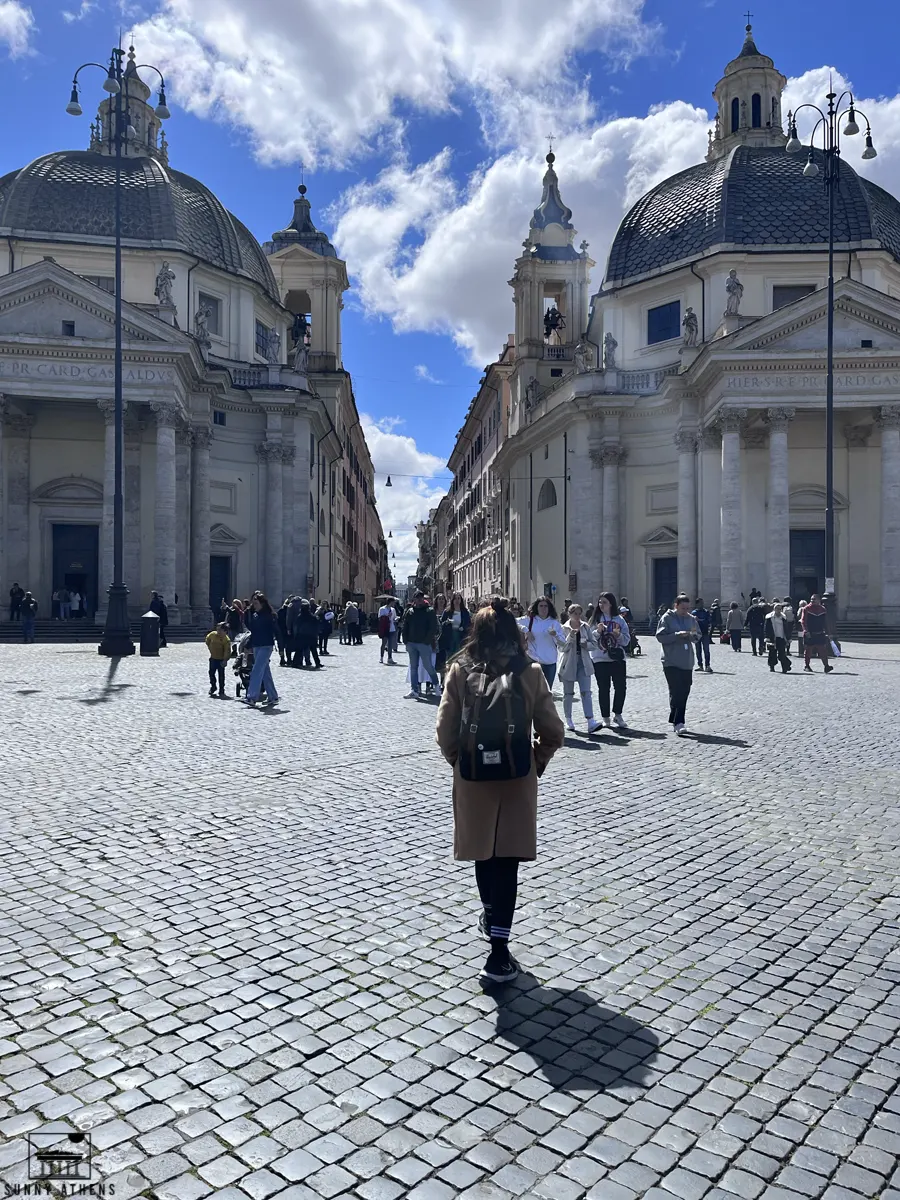
Why: Starting from Piazza del Popolo, you’ll come across one of the city’s most famous streets, Via del Corso.
Its name originates from the horse races that were held along this street during the fifteenth century.
Nowadays, it’s lined with dozens of shops and is enjoyable to stroll both day and night.
As you amble along, make sure to take a detour to visit Via Margutta, a parallel street that’s one of the city’s characteristic picturesque narrow lanes.
26. Spanish Square

Why: Together with Trevi Fountain, Spanish Square ranks among the most crowded landmarks in Rome.
Once you arrive, it’s easy to understand why, as the area is undeniably picturesque.
Locally known as Piazza di Spagna, it derives its name from the Embassy of Spain, which has its headquarters here.
Apart from the Spanish Steps, which I’ll elaborate on shortly, the surrounding area features landmarks such as the house of the writer Keats-Shelley, the Column of the Immaculate Conception depicting the Blessed Virgin Mary, and the Fountain of the Boat.
Regrettably, the fountain has been the target of vandalism in recent years, primarily by drunk tourists.
However, thanks to careful restorations, it remains as stunning as it was when completed in 1629.
27. Spanish Steps

Why: The design of the Spanish Steps was a subject of debate for about a century and a half.
Ultimately, the wait was well worth it, and the impressive project was finally realized in 1725.
The 135 steps serve as a connecting point between the Spanish Square and the Trinita dei Monti church situated directly above.
Interestingly, city authorities, in a bid to safeguard them from damage, introduced penalties in 2019 for any form of mistreatment.
As a result, it is now prohibited to even sit or eat on them!
28. Trinità dei Monti

Why: As you ascend the Spanish Steps, you’ll find yourself standing in front of Trinità dei Monti, another exceptional church in Rome that warrants a visit.
Constructed in 1502, it is the property of the French state, as is the entire surrounding area!
Inside, you’ll discover many art pieces, including mosaics, statues, and paintings.
If I had to highlight one, it would be the ‘Assumption of the Virgin’ by Daniele da Volterra, a pupil of Michelangelo.
However, the real treat is the panoramic view from the square just in front of the church.
Find a cozy spot and take your time to soak it all in.
29. St. Angelo Bridge

Why: The last leg of your 3-day Rome itinerary involves a leisurely stroll along Via dei Condotti, brimming with upscale shops.
Shortly after, you’ll reach the beautiful St. Angelo Bridge, which serves as a link between the historic city center and Castel Sant’Angelo.
Constructed in 134 BC by the Roman Emperor Hadrian, it was later adorned with statues of Saints Peter and Paul, along with ten angels.
Despite usually being crowded with tourists, the views of the castle and the neighborhood adjacent to Vatican City are nothing short of picturesque.
30. Castel Sant’Angelo

Why: Like St. Angelo Bridge, Castel Sant’Angelo was erected by Emperor Hadrian, originally intended as a mausoleum for himself and his family.
Hence, its original designation was the Mausoleum of Hadrian.
Over the centuries, its purpose changed, with many popes using it as a castle and later being converted into a prison.
Legend has it that an angel once appeared atop the building, earning it the name “Castle of the Holy Angel”.
Today, it operates as a museum, housing multiple exhibition rooms which could easily occupy 1-2 hours of your time.
However, I recommend you book tickets online in advance to bypass the potentially lengthy queues.
31. Even More Pasta

Why: You could say that Borghiciana Pastificio Artigianale is a small hidden gem of Rome.
It is a restaurant-pasta workshop that can accommodate a maximum of about 15 guests at a time.
As a result of its limited seating, you may find yourself waiting in line for a substantial period, especially during peak hours.
However, the homemade pasta it offers is the best way to complete your trip.
During our visit, we sampled the Rigatoni all’ Amatriciana and the Tonnarelli Carbonara.
Needless to say, both were flavorful and well-prepared.
Conclusion: what to add or skip

This comprehensive itinerary should be sufficient for you to spend 3 amazing days in Rome, taking in all the must-see landmarks.
Admittedly, it’s quite a packed schedule.
However, if you believe you can squeeze in a little more, then on the first day, be sure not to miss Gelateria La Romana.
Situated slightly outside the tourist center, it offers some of the best ice cream in town.
Ideally, visit either after the Trevi Fountain (point 12) or after dining at Tosca – Trattoria Pinseria (point 14).
As for the second day, if you’re up for some additional walking, the famous Circus Maximus is conveniently located near the Orange Trees Garden (point 22).
On the other hand, if this 3-day Rome itinerary seems a bit too intense, make sure to adopt a more relaxed pace.
Particularly, on the second day, take a taxi to Trastevere after your Vatican City visit, bypassing the walk to Janiculum Hill and Fontana dell’Acqua Paola (points 18 & 19).
Lastly, on the third day, consider skipping a visit inside Castel Sant’Angelo (point 30).
After crossing the St. Angelo Bridge, head straight for a meal at Borghiciana Pastificio Artigianale.
Plan Your Trip
Stay: Booking.com (best prices, great support)
Airport: Welcome Pickups (pre-booked, reliable airport transfers)
Drive: Rentalcars (compare prices, free cancellation)
Connect: Airalo eSIM (cheap data)
Do: GetYourGuide (unique tours & activities)
Fly: Skyscanner (find the cheapest flights)
Explore: GuruWalk (free walking tours worldwide)
Protect: SafetyWing (affordable travel insurance)
Sunny Athens is reader-supported. Some links on this page may be affiliate links, meaning we may earn a small commission at no extra cost to you, if you make a purchase. This helps support our work and keeps our travel tips honest and independent. Learn more in Advertise Disclosure.







